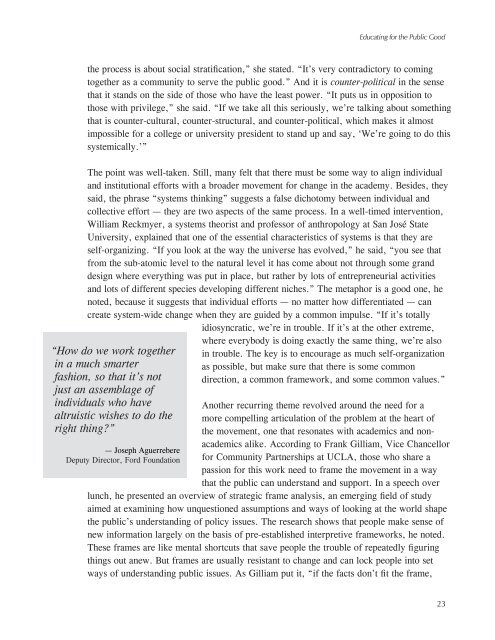The National Forum on Higher Education for the Public Good
The National Forum on Higher Education for the Public Good
The National Forum on Higher Education for the Public Good
You also want an ePaper? Increase the reach of your titles
YUMPU automatically turns print PDFs into web optimized ePapers that Google loves.
Educating <strong>for</strong> <strong>the</strong> <strong>Public</strong> <strong>Good</strong><strong>the</strong> process is about social stratificati<strong>on</strong>,” she stated. “It’s very c<strong>on</strong>tradictory to comingtoge<strong>the</strong>r as a community to serve <strong>the</strong> public good.” And it is counter-political in <strong>the</strong> sensethat it stands <strong>on</strong> <strong>the</strong> side of those who have <strong>the</strong> least power. “It puts us in oppositi<strong>on</strong> tothose with privilege,” she said. “If we take all this seriously, we’re talking about somethingthat is counter-cultural, counter-structural, and counter-political, which makes it almostimpossible <strong>for</strong> a college or university president to stand up and say, ‘We’re going to do thissystemically.’”<str<strong>on</strong>g>The</str<strong>on</strong>g> point was well-taken. Still, many felt that <strong>the</strong>re must be some way to align individualand instituti<strong>on</strong>al ef<strong>for</strong>ts with a broader movement <strong>for</strong> change in <strong>the</strong> academy. Besides, <strong>the</strong>ysaid, <strong>the</strong> phrase “systems thinking” suggests a false dichotomy between individual andcollective ef<strong>for</strong>t — <strong>the</strong>y are two aspects of <strong>the</strong> same process. In a well-timed interventi<strong>on</strong>,William Reckmyer, a systems <strong>the</strong>orist and professor of anthropology at San José StateUniversity, explained that <strong>on</strong>e of <strong>the</strong> essential characteristics of systems is that <strong>the</strong>y areself-organizing. “If you look at <strong>the</strong> way <strong>the</strong> universe has evolved,” he said, “you see thatfrom <strong>the</strong> sub-atomic level to <strong>the</strong> natural level it has come about not through some granddesign where everything was put in place, but ra<strong>the</strong>r by lots of entrepreneurial activitiesand lots of different species developing different niches.” <str<strong>on</strong>g>The</str<strong>on</strong>g> metaphor is a good <strong>on</strong>e, henoted, because it suggests that individual ef<strong>for</strong>ts — no matter how differentiated — cancreate system-wide change when <strong>the</strong>y are guided by a comm<strong>on</strong> impulse. “If it’s totallyidiosyncratic, we’re in trouble. If it’s at <strong>the</strong> o<strong>the</strong>r extreme,“How do we work toge<strong>the</strong>rin a much smarterfashi<strong>on</strong>, so that it’s notjust an assemblage ofindividuals who havealtruistic wishes to do <strong>the</strong>right thing?”— Joseph AguerrebereDeputy Director, Ford Foundati<strong>on</strong>where everybody is doing exactly <strong>the</strong> same thing, we’re alsoin trouble. <str<strong>on</strong>g>The</str<strong>on</strong>g> key is to encourage as much self-organizati<strong>on</strong>as possible, but make sure that <strong>the</strong>re is some comm<strong>on</strong>directi<strong>on</strong>, a comm<strong>on</strong> framework, and some comm<strong>on</strong> values.”Ano<strong>the</strong>r recurring <strong>the</strong>me revolved around <strong>the</strong> need <strong>for</strong> amore compelling articulati<strong>on</strong> of <strong>the</strong> problem at <strong>the</strong> heart of<strong>the</strong> movement, <strong>on</strong>e that res<strong>on</strong>ates with academics and n<strong>on</strong>academicsalike. According to Frank Gilliam, Vice Chancellor<strong>for</strong> Community Partnerships at UCLA, those who share apassi<strong>on</strong> <strong>for</strong> this work need to frame <strong>the</strong> movement in a waythat <strong>the</strong> public can understand and support. In a speech overlunch, he presented an overview of strategic frame analysis, an emerging field of studyaimed at examining how unquesti<strong>on</strong>ed assumpti<strong>on</strong>s and ways of looking at <strong>the</strong> world shape<strong>the</strong> public’s understanding of policy issues. <str<strong>on</strong>g>The</str<strong>on</strong>g> research shows that people make sense ofnew in<strong>for</strong>mati<strong>on</strong> largely <strong>on</strong> <strong>the</strong> basis of pre-established interpretive frameworks, he noted.<str<strong>on</strong>g>The</str<strong>on</strong>g>se frames are like mental shortcuts that save people <strong>the</strong> trouble of repeatedly figuringthings out anew. But frames are usually resistant to change and can lock people into setways of understanding public issues. As Gilliam put it, “if <strong>the</strong> facts d<strong>on</strong>’t fit <strong>the</strong> frame,23




